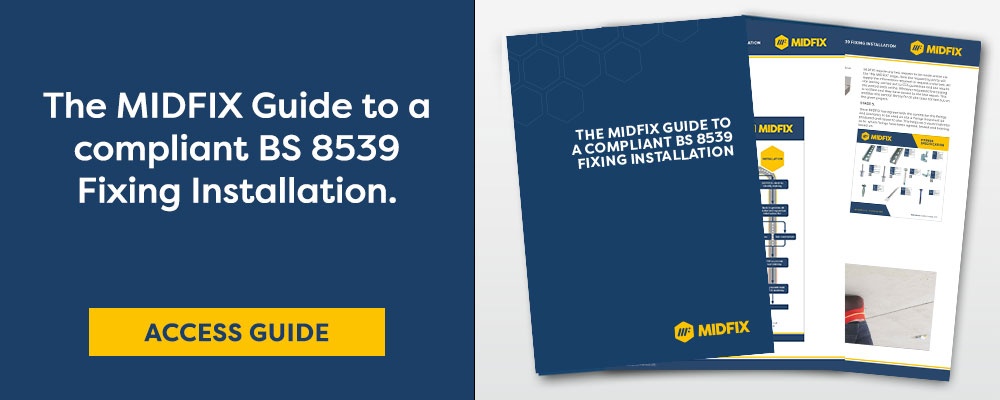It is well-known within the M&E sector that one of the reasons why deformation-controlled anchors (drop-in anchors) tend to fail is due to incorrect anchor installation. This is quite a worry, as the majority of deformation-controlled anchors support 'safety-critical' applications. Site failures can be mitigated if training requirements are identified earlier on in the project.
Compliant installation of anchors/fixings matter, because site failures not only cause site damage but also increase the risk of injury or loss of life to those on-site.
In our latest sound-out episode Stevan discusses how you can reduce the risk of anchor installation errors.
The article will also touch on the different training courses available to installers and supervisors.
BS 8539:2012 Code of Practice for the Selection and Installation of Anchors in Concrete and Masonry
The British standard sets out the rules and responsibilities for all parties from the specifier to the installer involved in the use of anchors. It was developed to reduce the amount of casulties due to site failures.
How does BS 8539 guide installers?
The BS 8539 offers guidance for anchor installers - anchors should only be installed and supervised by competent individuals. BS 8539 defines competent as:
‘Suitably trained and qualified by knowledge and practical experience, and provided with the necessary instructions, to enable the required task(s) to be carried out correctly.’
Learning points for correct anchor/fixing installation
- Always follow the manufacturer’s instructions.
- Understand how the anchor/fixing will fix into the substrate, is it cracked or non-cracked concrete, different substrates will affect the selection and installation of an anchor/fixing.
- Know the working principles of the anchor.
- Recognise the different anchor installation methods – is it a flush fix or a through-fix.
- Acknowledge how to correctly use all setting and installation tools e.g. torque wrench, torque specification and how to set the torque up correctly, impact driver, hammer, blow-out pump etc.
- Only use the setting tool required for that specific anchor
- Be aware of how to clean the hole before installing an anchor, if you don’t do that you will not get the bond required.
- Understand what to do if the installation goes wrong.
When should you stop an anchor/fixing installation?
• Rebar – If you strike a reinforcing bar whilst drilling
• Tension bars – If you strike tension bars whilst drilling
• If you come across an unknown base material
• If you do not have the required information such as drill diameter and depth to install the anchor
• If you do not have the relevant tools such as setting tools or torque wrenches etc
• If you are asked to install a non-specified anchor
Is there any further guidance from BS 8539?
Quite often installers learn on the job and stick to that method. After all, they have always installed anchors that way and they haven't failed. The issue is, that if a site failure occurs on-site and there is evidence to show that training hasn't been carried out to a standard (BS 8539) then there may be consequences.
BS 8539 installer training underlines the importance of using setting tools correctly;
‘When the anchor is originally supplied to site, the installer should look at the setting tools (e.g., torque wrench, torque specification and set the torque up correctly). The drill diameter, drill depth, recommended torque value and load-bearing should also be taken into consideration.’ Any specific setting tool should be designed for that particular anchor.
What happens if an installer is not suitably trained?
Most on-site anchor installation failures are due to incorrect installation. As BS 8539 outlines anchors should be installed by a competent individual. There may be consequences if an untrained and therefore unqualified individual installs an anchor into a ‘safety-critical' application.
What are safety-critical applications?
If the failure of an anchor could lead to injury or significant material or economic damage to the building, then the situation is deemed safety-critical. With most mechanical and electrical installations being suspended from the building’s ceilings, these are clearly safety-critical and anchors should be suitably approved and installed.
Have there been any severe cases of anchor installation failure?
In the past, there have been cases where anchor installation failure has led to assembled brackets collapsing.
The CFA (Construction Fixings Association) have highlighted two case studies showing the damaging effects of anchor installation failure -
CFA Case Study 1
CFA Case Study 2
What training options are available?
There are two main forms of training, one form is the traditional ‘toolbox talks’ whereby a qualified individual will visit you face-to-face to carry out training. The second option is virtual learning (MIDFIX Academy) whereby an installer can sit down in their leisure and complete an anchor installation training course online.
Why is it important to understand and comply with BS 8539?
Anchors are a small component to which little consideration is frequently given but are absolutely vital to preventing the collapse of the structure or installation that depends on them. Understanding how to correctly install anchors by completing a BS 8539 installer training is an important part of this process. It ultimately reduces the risk of site failure.
What core online training courses are available?
- BS8539:2012 awareness and best practice, aimed at the tier 1 contractor and subcontractor, installers, site managers, project managers, procurement members etc.
- Four installer training packs, covering deformation control anchors, through bolts, concrete screws, and resin anchors (chemical anchors)
- Supervisor awareness training
All courses are carried out online and are currently available as guided (trainer-led) and self-directed (unguided) courses. Each candidate will need to obtain a minimum pass mark via an interactive questionnaire.
Conclusion
All anchor/fixing installers and supervisors require training to carry out compliant anchor installations. Starting a project with the right conversations around anchors/fixings can mean that the specification, supply, training requirements, and anchor testing requirements are outlined within a fixing policy.



.png?width=768&name=MicrosoftTeams-image%20(362).png)